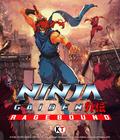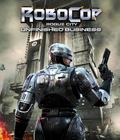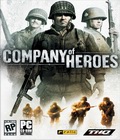Genre: Real Time Strategy
Publisher: THQ Inc
Developer: Relic Entertainment
Release Date: September 12, 2006
The real-time strategy genre is undergoing a dramatic transformation. It's just as well too, as this long-overdue shake-up may just save a great genre from going the way of the evanescent side-scroller. Despite new games being released that display some imaginative concepts, they've largely become stale and uninspiring. In part, this is because the genre has resisted the move to fully 3-D units and environments, but also because the gameplay has changed little. What we're seeing now with games like Relic's highly successful Warhammer 40,000: Dawn of War series and its latest title, Company of Heroes, is a fresh approach that is delivering an immersive and fun game experience. These games are also redefining the genre by shifting the focus from "real-time strategy" to "real-time tactics."
In Company of Heroes, the emphasis is not so much on winning major campaigns through the deployment of numerous and largely faceless forces. Instead, it takes a more personal, visceral approach that brings the excitement and action of blockbuster war movies to your PC. This is made possible by Relic's propriety next-generation Essence Engine, which delivers the most amazing dynamic lighting and shading effects seen in a game of this type. Coupled with the Havok 3.1 physics engine, beautifully rendered environments and units come to life like never before. They can also be destroyed like never before. Houses collapse dramatically after sustaining repeated damage; artillery strikes cause the landscape to erupt in fountains of dirt and debris and leave behind permanent craters; damaged vehicles can careen out of control, toppling telephone poles and anything else caught in their path; planes hit by anti-aircraft artillery plummet to the ground in fiery balls and demolition charges obliterate everything they're place on in spectacular Hollywood fashion. Graphically the game is an amazing experience. Brilliant sound effects and quality voice acting for the Americans – perhaps less so for the Germans – further adds to the sense of being in the midst of a World War II battle.
But as powerful as these engines are, there are some technical issues that can chip away at this near-perfect experience. Collision detection can be an issue at times, such as when two vehicles move next to each other and morph into one multi-barrelled behemoth. Framerates can also take a huge hit when observing the battle at lower, eye-level angles. Even the fastest machines may struggle to cope with large battles when watching the combat unfold at anything other than the default bird's eye view. The ability to adjust graphics settings in the Options menu, however, allows you to trade off graphic quality for increased framerate, if desired. I have also had the game crash to desktop several times despite having the latest patch (version 1.2 at the time of writing) and up-to-date drivers. Interestingly, if the game does crash, a dialogue box appears allowing you to specify what happened in an automatically generated report that can be sent off to Relic with a mouse click. This technical feedback is entirely optional and contains anonymous information to help developers investigate problems and provide remedies through future patches. It's a great innovation to improve the game's stability and performance.
Company of Heroes supports three different modes of play: Campaign, Skirmish and On-Line. The campaign is a single-player game in which you are given charge of the riflemen and tankers of Able Company, a fictitious company that fights its way across the Cotentin Peninsula in 15 lengthy missions that begin with the D-Day landing on Omaha Beach. Skirmish mode allows you to play as either the US or German sides against the AI on various multiplayer maps, while On-Line play allows up to eight players to fight as teams over a Local Area Network or through the Company of Heroes multiplayer lobby. Each mode provides its own set of challenges and is equally enjoyable.
In Campaign mode, missions are introduced with brilliant cut scenes made from in-game sequences, some of which are clearly inspired by movies such as Saving Private Ryan, and original artwork. An animated strategic map puts the current mission in its historical context, and the whole introduction is wonderfully narrated by a veteran of Omaha Beach. Beginning with the D-Day landing and concluding with closing moments of the Normandy campaign at Falaise, the missions progressively become more difficult and introduce new units and abilities for both you and the enemy. The campaign's missions are sufficiently varied to avoid repetitiveness and include offensive and defensive objectives such as capturing strategically important terrain, defending against an enemy assault, destroying a specific target and dominating the battlefield to accumulate more victory points than the enemy.
Using traditional real-time strategy elements such as base-building and a unique take on resource gathering, you begin the mission with a handful of core units. These will almost always include a headquarters building and an engineer unit that allow you to construct facilities used to build up your force and defend it from attack. The game includes a wide variety of supporting units including snipers, machine gun and mortar teams, the M1 57mm Antitank Gun, the M2 105mm Howitzer, the M8 Armored Car, three different variants of the Sherman, the M10 Tank Destroyer, the M26 Pershing and the P47 Thunderbolt. The Germans are similarly equipped with weapons such as the PAK 38 50mm Antitank Gun, 150mm Nebelwerfer Rocket Battery, the dreaded 88mm Flak 36 AT/AA Gun, the SdKfz 234/1 Armored Car, the Stug IV, the StuH 42, the Panzer IV, the Ostwind Flakpanzer, the Panther and the Tiger. One of my favorite units is the Goliath remote- controlled mini-tank, which can obliterate just about anything on the battlefield. Some units don't have to be built, such as rangers and paratroops, which can arrive as reinforcements when needed and as resources permit. Other "off-map" units can include artillery and tactical air reconnaissance and strikes. A great feature of the air support is the ability to not only target where you want it to attack, but also from what direction you want the aircraft to arrive and depart. This is useful, for example, when you want to strafe a line of enemy artillery pieces, but wish to avoid nearby anti-aircraft artillery.
Some of these units will only be available after you have chosen a specific Company Commander ability. There are three command streams available, including Infantry, Airborne and Armor for the US, and Defensive Doctrine, Blitzkrieg Doctrine and Terror Doctrine for the Germans. As you destroy the enemy and capture and hold territory, your efforts are rewarded with XP points. These can then be used to purchase abilities within your chosen command stream. For example, the Infantry Commander ability tree includes upgrades for defense and off-map artillery and Rangers. Each ability costs a certain number of points and when purchased unlocks the next ability. For the Germans, the various Doctrines unlock specific units including the notorious Tiger Ace Tank unit and abilities such as reinforcement and production bonuses.
Unlike other real-time strategy games where villagers discover and gather hidden strategic resources such as wood, gold and stone, resources in Company of Heroes are immediately visible on the Tactical Map and are secured by a "capture the flag" method. Once the flag has been captured, the associated resource, whether it is fuel or ammunition, slowly accumulates adding to the total that can be drawn on to build new units. Similarly, the number of men you can control is dictated by controlling Strategic Points in the same fashion. It's a unique twist on an old concept, but works well in the game and reinforces the need to not only capture, but also hold territory. Conversely, losing a territory sector or headquarters building will result in a decrease in manpower. Ensuring that a line of supply is maintained through ownership of contiguous territory sectors is also important. Without this, captured resources located in isolated territory will not be allowed to accumulate. In addition to utilizing resources to create new units, accumulated points can also be used to upgrade existing unit types. Some of the many upgrades include the ability to throw grenades and sticky bombs, add a .50 calibre machine gun mount to armored vehicles, allow infantry squads to construct defensive positions and permit light vehicles to capture flags.
In Skirmish and On-Line modes, the focus is on reducing your opponent's tickets through territorial control rather than achieving a specific mission-based objective. With up to eight teams and setup options, including the choice of each side starting with 250, 500 or 1,000 tickets, as well as random and standard starting locations and normal or high resources, these modes offer plenty of latitude to try out different tactics and can be very challenging. The available maps are just the right size and offer a good variety of terrain, including the notorious Normandy hedgerow countryside and superbly detailed urban and industrial terrain.
In addition to looking good, the maps present gamers with tactical challenges, which brings me back to my initial point about Company of Heroes being more of a real-time tactical game than a strategic one. Taking advantage of soft and hard cover for your infantry squads is important for their survival, as is the use of flanking techniques and suppressive fire. This applies to armored vehicles too, as armor ratings differ from the front, side and rear of the vehicle. Taking out a Tiger tank from the sides or rear, for example, will be easier than trying to defeat its tough front armor.
Although there are a number of difficulty levels for the AI, don't expect an easy game even when it's set on Normal. The AI is very aggressive and passive players will find the going tough. This is particularly the case in Skirmish mode, where capturing resources and Strategic Points at an early stage is imperative – but they must also be defended, or else they'll quickly be retaken. Finding a balance between offensive and defensive operations is challenging, and for some, the fast pace of the game may be overwhelming. Fortunately, the battlefield can be surveyed and orders issued in single-player mode at your leisure by using the keyboard's pause button.
Company of Heroes features two forms of AI, one that determines how a player's squad reacts to combat and the environment, and another that governs the computer opponent's troops. Every squad has an associated Attack Plan that controls their use of cover, and how they attack and is tailored to the different characteristics and roles of the different squads. Both the player's squads and those controlled by the computer will use their Attack Plans when engaging each other, allowing players to make tactical decisions without also having to micro-manage their troops.
Morale is modelled for the AI troops, who will break and flee if the stress of battle becomes overwhelming. Units belonging to the player, however, truly are "heroes" and will die fighting rather than retreat unless ordered. If the command to retreat is given, they'll rush back to your headquarters building and wait there until given new orders. Here they can be reinforced or "healed" if a Triage Center has been constructed nearby and returned to battle. Preserving your units, rather than letting them fight to the last man, is rewarded through veterancy, which makes units more effective in battle and gives you access to additional weapons and upgrades.
In Company of Heroes, liberties have been taken with realism and, to a degree, with historical accuracy. An example is the inclusion of the M26 Pershing tank, which didn't enter service until the Battle of the Bulge, six months after the Normandy invasion. But then, as gamers familiar with the real-time strategy genre will know, gameplay usually takes priority over historical accuracy. Relic, however, has tried to balance the two as much as possible. While, for example, armoured vehicles are built on-site rather than being shipped across the Atlantic, their armor and speed ratings are taken from real-life data. It's also good to see that small arms fire doesn't damage armored vehicles the way it does in many other real-time strategy games.
Company of Heroes is very accessible, with familiar real-time strategy controls including the standard left-click to select a unit and right click to move combination as well as the need to move the mouse to the side of the screen to scroll the map. A little different, although no doubt familiar to Warhammer: 40,000 players, is the requirement to hold down the ALT key while moving the mouse to reposition the camera. Game information is displayed at the bottom of the screen with a mini-map located in the left corner that shows victory locations as well as friendly and visible enemy units. The details of the currently selected unit can be found in the center panel, while unit build options are located in the bottom right corner. Learning how to play the game is made simple with the inclusion of several tutorials that guide new players through the game's main concepts. Of less help, but still worth checking out, is the short game manual that briefly covers gameplay as well as the US and German units. While I'm on the subject of accessibility, I should point out that the game carries an ESRB rating of Mature 17+ due, in large measure, to the coarse language that's used.
Although the title doesn't ship with any tools to create new maps or edit units, a host of official editors will be made available in the future. These will include:
- The Movie Maker, which allows users to create their own movies using scripted actions and sequences.
- The Unit Editor, allowing players to customize unit attributes and abilities in addition to importing their own models.
- The Attribute Editor, which allows modders to change the properties, such as resistance to damage or flammability, of objects found in the game.
- The Map Maker, allowing users to create their own maps.
 Company of Heroes is without doubt a fun and addictive game. In many ways, it has done for real-time strategy what the Battlefield franchise did for first-person shooters. It has made it an immersive and enjoyable experience that is both challenging and fun to play and will help ensure the genre remains popular with gamers for years to come.
Company of Heroes is without doubt a fun and addictive game. In many ways, it has done for real-time strategy what the Battlefield franchise did for first-person shooters. It has made it an immersive and enjoyable experience that is both challenging and fun to play and will help ensure the genre remains popular with gamers for years to come.
Score: 9.5/10
More articles about Company Of Heroes











 Company of Heroes delivers the World War II real-time strategy classic and both its expansions in one battle-hardened bundle.
Company of Heroes delivers the World War II real-time strategy classic and both its expansions in one battle-hardened bundle.


























































